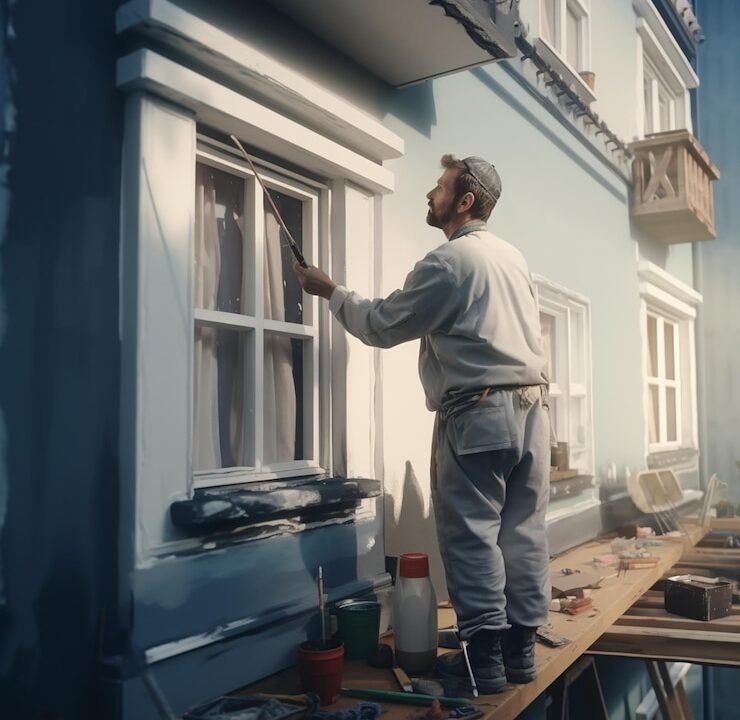
When it comes to boosting curb appeal and giving your home an instant facelift, few DIY projects deliver results as dramatic as painting the exterior. A fresh coat of paint not only enhances the beauty of your home but also helps protect it from the elements. Best of all, it’s a project you can tackle yourself—with the right tools, planning, and a bit of grit.
Whether you’re updating your faded siding, modernizing with a bold color choice, or just touching up trim, this guide will walk you through a DIY home exterior transformation that can turn “worn” into “wow.”
Why DIY Exterior Painting?
You might be wondering: is painting the outside of my house myself really worth the effort?
Absolutely—and here’s why:
- Save thousands in labor costs
- Customize your look exactly how you want it
- Increase home value and resale appeal
- Gain a sense of pride and accomplishment
- Extend the life of your siding or brickwork
If you have the time, patience, and basic know-how, this is one of the most rewarding DIY home transformations you can do.
Step 1: Plan Your Painting Project
Before you grab a brush or roller, you need a solid plan.
✅ Choose Your Color Wisely
Picking the right exterior color sets the tone for your home’s style.
Tips:
- Check neighborhood HOA rules if applicable
- Use paint visualizer apps to test colors
- Consider light reflectance (light colors reflect more sun)
- Don’t forget accent colors for shutters, doors, and trim
Popular combos:
- Navy blue with white trim
- Soft gray with black shutters
- White with a red door
- Sage green with cream accents
✅ Consider the Surface
What material are you painting?
- Wood siding
- Stucco
- Brick
- Vinyl siding
- Fiber cement
Each surface may require a different paint type or primer, so read labels carefully.
Step 2: Gather the Right Supplies
Here’s your essential DIY exterior painting checklist:
🧰 Tools & Supplies:
- Exterior primer
- High-quality exterior paint
- Rollers (long nap for textured surfaces)
- Angled brushes for trim
- Paint sprayer (optional but helpful for large areas)
- Extension pole
- Drop cloths or tarps
- Masking tape
- Ladder or scaffolding
- Caulk & caulking gun
- Sandpaper or wire brush
- Power washer
- Safety gear (goggles, gloves, respirator mask)
Pro Tip: Don’t cheap out on paint—invest in high-quality, weather-resistant exterior paint. It lasts longer and applies smoother.
Step 3: Prep Like a Pro
Preparation is where most of the hard work happens—but it’s also what guarantees a flawless finish.
🧼 Clean the Surface
Use a power washer to remove dirt, mildew, and grime. Let the surface dry completely (24–48 hours).
🔧 Repair Damage
- Fill holes and cracks with exterior-grade filler
- Replace rotted wood or damaged siding
- Caulk gaps around doors and windows
- Scrape peeling paint and sand rough spots
🛡️ Protect Landscaping & Fixtures
Cover bushes, decks, railings, AC units, and pathways with drop cloths or plastic sheeting.
Step 4: Prime Time
Priming is essential if:
- You’re painting over raw wood, stucco, or metal
- You’re covering a dark or stained color
- Your surface has been patched or repaired
- The existing paint is chalky or flaking
Use a high-quality exterior primer and apply it with a brush or roller. Let it dry completely before applying paint.
Step 5: Paint Like a Pro
🎨 Application Methods
Brush & Roller:
- Ideal for small homes or detail work
- More control but more time-consuming
Paint Sprayer:
- Perfect for large surfaces
- Fast and efficient
- Requires masking and practice
🧱 Painting Technique
- Start at the top and work your way down
- Paint in the shade, not direct sunlight
- Use long, even strokes
- Keep a wet edge to avoid lap marks
- Paint in sections: siding first, then trim, then doors/shutters
Apply at least two coats, allowing proper drying time between each (typically 4–6 hours depending on weather).
Step 6: Paint Trim, Doors & Accents
These are the details that really make your exterior pop.
🖌️ Trim & Accents
- Use a smaller angled brush for sharp lines
- Painter’s tape helps create crisp edges
- Consider contrast colors for dramatic effect
🚪 Doors
- Remove hardware or tape over
- Sand lightly before painting
- Use a satin or semi-gloss finish for durability
🎯 Popular Accent Colors
- Red, black, teal, or mustard yellow for doors
- Crisp white, charcoal, or navy for trim
- Matte black or bronze for shutters
Step 7: Clean Up & Celebrate
🧼 Post-Paint Cleanup
- Clean brushes and rollers with soap and water (or mineral spirits if using oil-based paint)
- Remove painter’s tape before paint fully cures
- Store leftover paint for future touch-ups
- Properly dispose of old cans or chemicals
📸 Document Your Work
Take before-and-after photos—you’ll be amazed by the transformation.
Then, sit back and admire the results of your hard work. You just gave your house a fresh, new look—all by yourself!
Tips for DIY Exterior Painting Success
☀️ Watch the Weather
Ideal conditions:
- Dry, mild days (between 50–85°F)
- Overcast or lightly sunny
- No wind or rain in the forecast
🕰️ Take Your Time
Rushing can lead to uneven coats, drips, and frustration. Block out several weekends or a full week, depending on house size.
🧽 Maintenance Matters
Once you’ve painted:
- Clean your exterior once or twice a year
- Touch up chips and cracks early
- Repaint every 7–10 years (or sooner for darker colors)
Before and After: DIY Exterior Success Stories
🏠 Story #1 – The Faded Farmhouse
Old beige siding got a crisp white makeover with black trim and a barn red door. Total cost? $750. Looks like a brand-new build.
🏡 Story #2 – The 80s Brick Beauty
Dark orange brick went light gray with limewash paint. Accents in navy blue. Family DIY’d it in one week for under $1,000.
🏘️ Story #3 – The Cottage Refresh
Small blue cottage got a sunny yellow upgrade with white scalloped trim. Budget: $500. Neighbors are still talking about it.
Common Mistakes to Avoid
- Skipping prep work
- Not testing colors in real lighting
- Using interior paint outdoors (big no-no!)
- Painting in direct sunlight
- Not using primer on porous surfaces
- Painting over dirty or moldy surfaces
Avoid these, and your paint job will not only look great—it’ll last for years.
Conclusion: Turn Heads with Your DIY Exterior Transformation
Painting the outside of your house is no small task—but it’s also one of the most satisfying DIY projects you can take on. With every stroke, you’re not just adding color—you’re adding character, protection, and pride in your home.
So go ahead—grab those brushes, pick your color, and transform your home’s exterior from faded to fabulous. The results will wow your neighbors, boost your curb appeal, and remind you just how powerful DIY can be.








